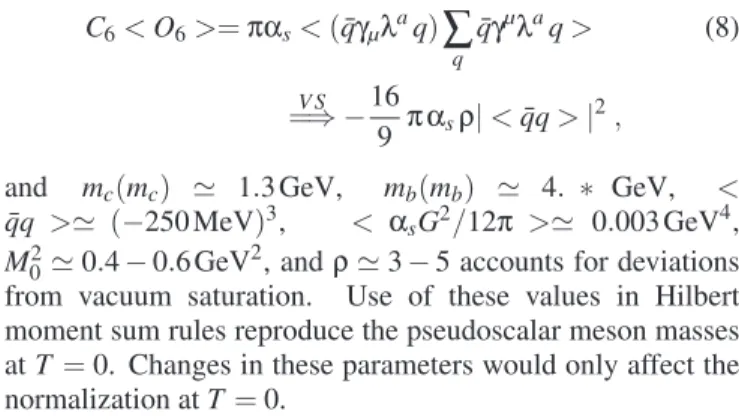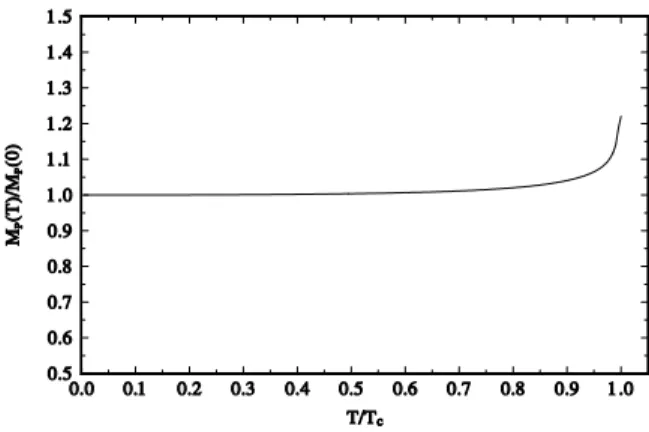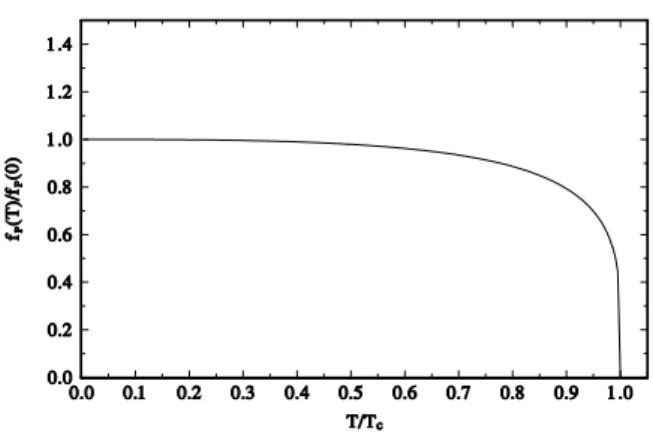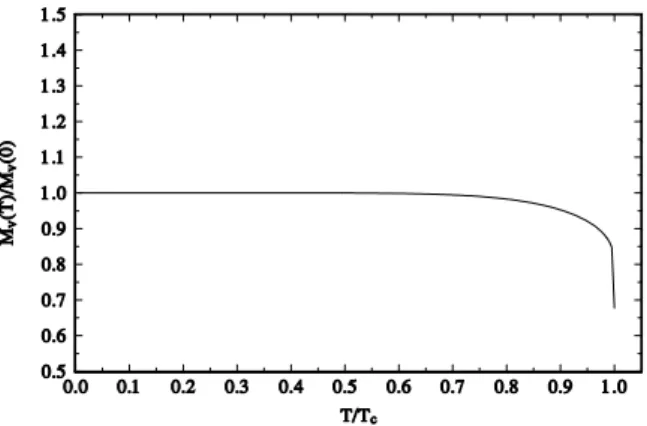.
Thermal Properties of Heavy-Light Quark Pseudoscalar and Vector Mesons
Cesareo A. Dominguez∗
Centre for Theoretical Physics and Astrophysics, University of Cape Town, Rondebosch 7700, South Africa Department of Physics, Stellenbosch University, Stellenbosch 7600, South Africa.
Marcelo Loewe†
Facultad de F´ısica, Pontificia Universidad Cat´olica de Chile, Casilla 306, Santiago 22, Chile.
Juan Cristobal Rojas‡
Departamento de F´ısica, Universidad Cat´olica del Norte, Casilla 1280, Antofagasta, Chile. (Received on 15 April, 2008)
The thermal behaviour of the mass, leptonic decay constant, and width of heavy-light quark peseudoscalar and vector mesons is analized in the framework of thermal Hilbert moment QCD sum rules. In all the cases, the meson leptonic decay constants decrease with increasingT, and vanish at a critical temperatureTc, while the mesons develop a width which increases dramatically, diverging whenT→Tc, whereTcis the temperature for chiral-symmetry restoration. The spectral function becomes a smooth function of the energy. This is interpreted as a signal for deconfinement atT =Tc. In contrast, the thermal masses are stable, except whenT→Tc, where the pseudoscalar meson mass increases slightly by 10-20 %, and the vector meson mass decreases by some 20-30 %.
Keywords: Finite temperature field theory; QCD Sum Rules
1. INTRODUCTION
The discussion of hadronic Green’s functions at finite tem-perature, in a variety of frameworks, is crucial in understand-ing the dynamics of the quark-gluon plasma. One such frame-work is that of QCD sum rules [1], based on the Operator Product Expansion (OPE) of current correlators beyond per-turbation theory, and on the notion of quark-hadron duality. This program was extended to the finite temperature scenario in [2]. It is based on two assumptions, (a) that the OPE remains valid, with temperature dependent vacuum conden-sates, and (b) that the quark-hadron duality also remains valid. Additional evidence supporting these assumptions was pro-vided in [3]. This analysis suggests strongly that at finite tem-perature stable particles atT =0 develop a non-zero width and resonances become broader, diverging at a critical decon-fining temperature (Tc). This width is a result of particle ab-sorption in the thermal bath. The analysis shows that the onset of the continuum decreases and approaches threshold nearTc. This technique provides also evidence for the equality of the critical temperatures for deconfinement and chiral-symmetry restoration [6]. WhenT →Tchadrons seem to melt and dis-appear from the hadronic spectral functions. This scenario is further supported by the thermal behaviour of electromagnetic mean-squared radii, which also diverge atTc[4]. On the con-trary, the thermal mass evolution is not a relevant signal for
∗Electronic address:cad@science.uct.ac.za †Electronic address:mloewe@fis.puc.cl ‡Electronic address:jurojas@ucn.cl
deconfinement. Conceptually, given either the emergence or the broadening of an existing width, together with its diver-gence atTc, the concept of mass looses its meaning. In prac-tice, in some cases the mass increases slightly with increasing T, and in others it decreases.
In this paper we use Hilbert moment QCD sum rules for heavy-light quark pseudoscalar and vector meson correla-tors to determine the temperature behaviour of the hadronic masses, couplings, and widths. For more details, see [7].At T=0 this problem was discussed in [8]-[9]. While there are only four ground-state pseudoscalar heavy-light quark mesons in the spectrum (D,Ds,B, andBs), and similarly for vector mesons, it is possible to determine the decay constants for ar-bitrary meson masses in a self-consistent way [9]. It turns out that the meson masses are basically independent ofT, except very close toTc where they increase slightly (pseudoscalars) by 10 - 20 %, or decrease (vector mesons) by 20-30 %. Here Tcis the critical temperature for chiral-symmetry restoration. The leptonic decay constants decrease with increasingT, and vanish at the critical temperature. Pseudoscalar and vector mesons develop a non-zero hadronic width that increases with T diverging atTc. These results provide evidence for quark deconfinement atT=Tc.
2. PSEUDOSCALAR MESONS
ψ5(q2,T) =i
Z
d4x eiqx θ(x0) (1) <<|[∂µAµ(x),∂νA†ν(0)]|>>,
where∂µA
µ(x) =mQ: ¯q(x)iγ5Q¯(x): ,q(Q) refers to the light (heavy) quark, and mQ>>mq is assumed. The matrix ele-ment above is the Gibbs average
<<A·B>>= 1
Z
∑
n exp(−En/T)<n|A·B|n> , (2) where|n>is any complete set of eigenstates of the (QCD) Hamiltonian andZ=Tr(exp(−(H/T))is the partition func-tion. We use here the quark-gluon basis, which allows for a smooth extension of the QCD sum rule program to non-zero temperature [3]. AtT=0 and to leading order in PQCD [10]1
πImψ5(x,0) =
3 8π2m
4
Q
(1−x)2
x , (3)
wherex≡m2Q/s, withs≥m2Q, and 0≤x≤1. At finite temper-ature contribute both the so called scattering term (q2 space-like), and the annihilation term (q2time-like) [2] to the corre-lator. We find the former to be exponentially suppressed, so that it can be safely neglected, while the latter is given by
1
πImψ5(x,T) =
1
πImψ5(x,0) (4) (
1−nF h ω
2T(1+x)
i −nF
h ω
2T(1−x)
i )
,
whereImψ5(x,0)is given by Eq.(3),nF(z) = (1+ez)−1is the Fermi thermal function, and in the rest frame (q=0) of the thermal bathx=m2Q/ω2. The first thermal function is expo-nentially suppressed and can be safely neglected for temper-atures of order
O
(100−200 MeV), but the second one does contribute near threshold.Up to dimensiond=6 the non-perturbative expansion of the correlator atT =0 is given by [8]
ψ5(q2)|NP=αC4<O4>+βC5<O5>+γC6<O6> (5) whereα=m2
Q/(m2Q−q2),β=mQ3q2/4(m2Q−q2)3and γ=m
2
Q 6
" 2
(m2
Q−q2)2
− m
2
Q
(m2
Q−q2)3
− m
4
Q
(m2
Q−q2)4 #
Our condensates are
C4<O4>= 1
12π <αsG
2>
−mQ<q q¯ >, (6)
C5<O5>=<gsq i¯ σµνGaµνλaq>≡2M02 <q q¯ > , (7)
C6<O6>=παs<(q¯γµλaq)
∑
q¯
qγµλaq> (8) V S
=⇒ −16
9 π αsρ|<qq¯ >| 2,
and mc(mc) ≃ 1.3 GeV, mb(mb) ≃ 4. ∗ GeV, < ¯
qq >≃ (−250 MeV)3, < α
sG2/12π >≃ 0.003 GeV4,
M02≃0.4−0.6 GeV2, andρ≃3−5 accounts for deviations from vacuum saturation. Use of these values in Hilbert moment sum rules reproduce the pseudoscalar meson masses atT =0. Changes in these parameters would only affect the normalization atT=0.
For the light-quark condensate at finite temperature we use the result of [11], obtained in the composite operator formal-ism, valid for the whole range of temperaturesT =0−Tc, where Tc is the critical temperature for chiral symmetry restoration. There is lattice evidence [12] as well as analytical evidence [6] for this critical temperature to be the same as that for deconfinement. The ratioR(T) =<<qq¯ >> / <qq¯ > from [11] as a function ofT/Tcis shown in Fig. 1 .
The low temperature expansion of the gluon condensate is proportional to the trace of the energy-momentum tensor, and it starts only at orderT8[13]. To a good approximation it can be written as
<< αs 12πG
2>>=< αs 12πG
2>h1−³T Tc
´8i
. (9)
FIG. 1: The light-quark condensate ratioR(T) =<<qq¯ >> / <qq¯ > as a function ofT/Tcfrom [11].
of the low temperature expansion (chiral perturbation theory) with and without assuming vacuum saturation. They are in fact numerically different. However, this result is only valid at very low temperatures (T << fπ); hence it cannot be
ex-trapolated toT ≃Tc. In fact, both the quark condensate and the four-quark condensate should vanish at the same temper-ature T =Tc. In any case, numerically, at temperatures of orderT≃100 MeV the quark condensate dominates over the gluon condensate, the dimensiond=5 condensate is compa-rable to<<qq¯ >>, and the dimensiond =6 condensate is almost two orders of magnitude smaller. Hence, potential vi-olations of vacuum saturation can be safely ignored. Finally, at finite temperature it is possible, in principle, to have non-zero values of non-diagonal (Lorentz non-invariant) vacuum condensates. There is one example discussed in the literature [15] with enough detail to make a numerical estimate of their importance, and it refers to operators of spin-two (quark and gluon energy momentum tensors). The low temperature ex-pansion of these terms starts at order
O
(T4), in contrast to a T2dependence of the diagonal condensates. We find that at temperatures of orderT ≃100 MeV both non-diagonal con-densates are three orders of magnitude smaller than the cor-responding diagonal equivalents. We shall then ignore non-diagonal condensates in the sequel.FIG. 2: The ratios0(T)/s0(0), Eq.(14), as a function ofT/Tcfor mQ=mc.
If we go now into the hadronic sector,, the spectral function atT=0 can be written as
1
πImψ5(s)|HAD= 2f
2
PM4Pδ(s−M2P) + (10) θ(s−s0)
1
πImψ5(s)|PQCD,
whereMPand fPare the mass and leptonic decay constant of the pseudoscalar meson, and the continuum, starting at some thresholds0, is modeled by perturbative QCD. With this nor-malization, fπ≃93MeV. Our previous experience with
ther-mal evolution of two point functions according to finite energy
sum rules suggests us strongly to anticipate the pseudoscalar mesons to develop a sizable widthΓP(T) at finite temper-ature (particle absorption in the thermal bath), and using a Breit-Wigner parametrization, the following replacement will be understood
δ(s−MP2) =⇒const 1
(s−MP2)2+M2
PΓ2P
, (11)
where the mass and width areT−dependent, and the constant is fixed by requiring equality of areas, e.g. if the integration is in the interval(0−∞)thenconst=2MPΓP/π. The continuum
FIG. 3: The ratioMP(T)/MP(0)as a function ofT/Tc.
thresholds0 above also depends on temperature; to a good approximation it scales universally as the quark condensate [16], i.e.
s0(T) s0(0) ≈
<<qq¯ >>
<qq¯ > , (12) wheres0(0)is clearly channel dependent. At the critical tem-perature we expects0(Tc) =m2Q, in which case Eq. (13) can be rewritten as
s0(T) s0(0) ≈
<<qq¯ >> <qq¯ >
"
1− m
2
Q
s0(0)
#
+ m
2
Q
s0(0)
, (13)
This is shown in Fig. 2 for the case mQ = mc and
s0(0) =5GeV2; a qualitatively similar behaviour is obtained formQ=mbands0(0)≃(1.1−1.3)MB2.
The correlation functionψ5(q2,T), Eq.(1), satisfies a twice subtracted dispersion relation. To eliminate the subtractions one can use Hilbert moments atQ2≡ −q2=0, i.e.
ϕ(N)(T) ≡ (−) N+1
(N+1)! ³ d
dQ2
´N+1
ψ5(Q2,T)|Q2=0 (14)
= 1
π Z ∞
m2
Q
ds
FIG. 4: The ratiofP(T)/fP(0)as a function ofT/Tc.
whereN=1,2, .... Invoking quark-hadron duality
ϕ(N)(T)|HAD=ϕ(N)(T)|QCD, (15)
FIG. 5: The widthΓP(T))as a function ofT/Tc, withΓP(0) =0.
and combining the continuum contribution in the hadronic spectral function with the PQCD piece of the QCD counter-part leads to the finite energy Hilbert moments
1
π Z s0(T)
0
ds
sN+2Imψ5(s,T)|POLE= 1
π Z s0(T)
m2Q
ds
sN+2Imψ5(s,T)|PQCD+ϕ (N)(T)
|NP, (16)
whereImψ5(s,T)|POLE is given by the first term in Eq.(11) modified according to Eq.(12), the PQCD spectral function corresponds to Eq.(4), and
ϕ(N)(T)|NP= A
m2QN+2
· 1− 1
12π
<<αsG2>>
A
−1
4(N+2)(N+1) M20 m2
Q
−4
81(N+2)(N
2+10N+9)π α
sρ
<<qq¯ >> m3
Q #
(17)
where we introducedA=−mQ<<qq¯ >>. Using the first three moments one obtains the temperature dependence of the mass, the leptonic decay constant, and the width. Results from this procedure are shown in Figs.3-5 for the charm case; in the case of beauty mesons, results are qualitatively similar.
3. VECTOR MESONS
We consider the correlator of the heavy-light quark vector current
Πµν(q2,T) =i
Z
d4xeiqxθ(x0)<<|[Vµ(x),Vν†(0)]|>>
=−(gµνq2−qµqν)Π(1)(q2,T) +qµqνΠ(0)(q2,T)
(18)
whereVµ(x) =:q(x)γµQ(x):.In the sum rule we shall use the function−Q2Π(1)(q2,T), which is free of kinematical singu-larities. A straightforward calculation gives
1
πImΠ
(1)(x,T) = 1
8π2(1−x) 2(
2+x)
×h1−nF ¡
z+¢−nF ¡
z−¢i, (19) wherez±≡2ωT(1±x). In the hadronic sector, we define the vector meson leptonic decay constantfV through
<0|Vµ(0)|V(k)>= √
2MV fVεµ, (20) so that the pole contribution to the hadronic spectral function is 2fV2δ(s−MV2). AtT =0 the vector MesonD∗(2010)has a very small width in the keV range(96±22)keV which we expect to increase with increasingT, so that the replacement in Eq.(12) will be made.
The Hilbert moments at Q2 = 0 of the function −Q2Π(1)(Q2)are given by
ϕ(N)(T) ≡ (−) N+1
(N+1)! ³ d
dQ2
´N+1
[−Q2Π(1)(Q2,T)]|Q2=0
= 1
π Z ∞
m2
Q
ds sN+1ImΠ
FIG. 6: The ratioMV(T)/MV(0)as a function ofT/Tc.
FIG. 7: The widthΓV(T)as a function ofT/Tc.
Following the same procedure as for the pseudoscalar mesons (see Eq. (17)), the sum rules become
1
π Z s0(T)
0
ds sN+1ImΠ
(1)(s,T)|POLE=
1
π Z s0(T)
m2Q
ds sN+1ImΠ
(1)(s,T)|PQCD+ϕ(N)(T)|NP, (22)
whereϕ(N)(T)|NPis given by
ϕ(N)(T)|NP=− A m2QN+4
h
1−<<αsG
2>>
12πA −
(N+2)(N+3)
4
M20 m2Q+ 4
81(N+2)(20+N−N 2)π α
sρ
<<qq¯ >> m3Q
i
, (23)
where we used once againA=−mQ<<qq¯ >>. Using the first three Hilbert moments to find the temperature depen-dence of the hadronic parameters, we obtain for the mass and the width ofD∗(2010)the results shown in Figs.6-7. The be-haviour of the vector-meson leptonic decay constant is essen-tially the same as that of the pseudoscalar-meson shown in Fig.4. Similar results are found for the case of the beauty vec-tor mesonB∗.
4. CONCLUSIONS
The thermal behavior of pseudoscalar and vector meson de-cay constants, masses, and widths was obtained in the frame-work of Hilbert moment finite energy QCD sum rules. This behaviour is basically determined by the thermal light quark condensate on the QCD sector, and by the T-dependent con-tinuum threshold on the hadronic sector. Normalizing the values atT =0, and using the method of [9] for arbitrary masses, there follows a universal relation for the hadronic parameters as a function ofT/Tc.Results show that the de-cay constants decrease with increasing temperature, vanish-ing at T =Tc, while the widths increase and diverge at the critical temperature. Such a behavior provides (analytical) ev-idence for quark-gluon deconfinement, and is in qualitative agreement with corresponding results obtained in the light-quark sector. Finally, pseudoscalar meson masses increase slightly with temperature by some 10−20%, while the vector masses decrease by 20−30%. Given the dramatic emergence of monotonically increasing widthsΓ(T), there is little if any significance of this temperature behaviour of the masses, i.e. the relevant signals for deconfinement are the vanishing of the leptonic decay constants and the divergence of the widths at T=Tc.
Acknowledgments
[1] For a recent review see e.g. P. Colangelo, A. Khodjamirian, in: ”At the Frontier of Particle Physics/ Handbook of QCD”’, M. Shifman, ed. (World Scientific, Singapore 2001), Vol. 3, 1495-1576.
[2] A. I. Bochkarev, M. E. Shaposnikov, Nucl. Phys. B286, 220 (1986).
[3] C. A. Dominguez, M. Loewe, Phys. Rev. D52, 3143 (1995). [4] C. A. Dominguez, M. Loewe, and J. S. Rozowsky, Phys. Lett. B
335, 506 (1994); C. A. Dominguez, M. S. Fetea, and M. Loewe, Phys. Lett. B406, 149 (1997); C. A. Dominguez, M. Loewe, and C. van Gend, Phys. Lett. B429, 64 (1998);ibidB460, 442 (1999).
[5] R. J. Furnstahl, T. Hatsuda, and S. H. Lee, Phys. Rev. D42, 1744 (1990); C. Adami, T. Hatsuda, and I. Zahed, Phys. Rev. D
43, 921 (1991); C. Adami and I. Zahed, Phys. Rev. D45, 4312 (1992); T. Hatsuda, Y. Koike, and S.-H. Lee, Phys. Rev. D47, 1225 (1993); Nucl. Phys. B394, 221 (1993); Y. Koike, Phys. Rev. D48, 2313 (1993).
[6] C. A. Dominguez, M. Loewe, Phys. Lett. B233, 201 (1989); A. Barducci, R. Casalbuoni, S. de Curtis, R. Gatto, and G. Pettini,
Phys. Lett. B244, 311 (1990).
[7] C. A. Dominguez, M. Loewe, and J. C. Rojas, JHEP08, 040 (2007).
[8] C. A. Dominguez, N. Paver, Phys. Lett. B197, 423 (1987);ibid. B207, 499 (1988), Erratum-ibid.B211, 500 (1988);ibid.B
318, 629 (1993).
[9] C. A. Dominguez, N. Paver, Phys. Lett. B246, 493 (1990). [10] D. J. Broadhurst, Phys. Lett. B101, 423 (1981); D. J.
Broad-hurst, S. C. Generalis, Open University Report No. OUT-4102-8 (19OUT-4102-82) (unpublished).
[11] A. Barducci, R. Casalbuoni, S. de Curtis, R. Gatto, and G. Pet-tini, Phys. Rev. D46, 2203 (1992).
[12] F. Karsch, J. Phys. G34, S627-S6230 (2007).
[13] P. Gerber, H. Leutwyler, Nucl. Phys. B321, 387 (1989). [14] V. L. Eletsky, Phys. Lett. B299, 111 (1993).
[15] V. L. Eletsky, Phys. Lett. B352, 440 (1995).
[16] C. A. Dominguez, M. S. Fetea, and M. Loewe, Phys. Lett. B



